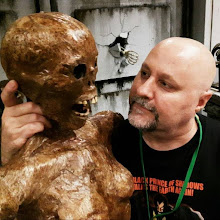The following post is based on a paper I presented at TV Fangdom: A Conference on Television Vampires (June 7-8, 2013). There is much discussion devoted to modern vampires, in series such as True Blood, Buffy the Vampire Slayer, and The Vampire Diaries. But to truly appreciate today's bloodsuckers, one must explore how they evolved on television, a process that has spanned over sixty years.
In part three of this lighthearted look at TV vampires, I examine modern productions, from 1990-Present. (Read part one | Read part two)
Modern Times: 1990-Present
These days, traditional song-and-dance variety programming is all but dead; as such, sketch comedy and talk shows have become the primary showcase for delivering popular culture to the masses. Vampires have appeared on Saturday Night Live, SCTV, MADtv, and The Kids in the Hall.Talk show hosts such as Conan O’Brien and Jimmy Fallon often skewer our modern fascination with the romantic, brooding undead. O'Brien satirically jumped on the Twilight bandwagon with the introduction of a new personal assistant, Cody Devereaux. This Edward Cullen-inspired character was born in 1589; he's a depressed, misunderstood vampire "full of heartache and longing." Jimmy Fallon created a behind the scenes short film called Suckers, where a new writer named Angelique joins the Late Night staff, only to discover her coworkers are all vampires (this parodies the Twilight films, True Blood and The Vampire Diaries, with a hint of Dark Shadows). Fallon also created a series of segments called "Bothered with Robert Pattinson," where the actor climbs a tree and complains about things that bother him. There's even an official website: http://www.robertisbothered.com/
Since the 1990s, even though sketch comedy and talk shows have produced the most vampires in variety programming, there are still two notable productions that showcase the undead in a new and interesting light.
 |
| Omar Ebrahim as Ripley |
The Vampyr: A Soap Opera is a UK production from 1992, and is based on the 1898 opera Der Vampyr, which is itself an adaptation of John Polidori’s “The Vampyre” (1819). In this story, the vampire Ripley is unearthed in old London. Satan demands that he take the lives of three women in as many days, after which his soul will be renewed. The story can be quite complicated at times, although it benefits from the addition of a narrator, to help keep the audience up to speed. In this clip, Ripley is hunting down his first victim.
 |
| Zhang Wei-Qiang as Dracula |
The second production is Dracula: Pages from a Virgin’s Diary, a 2002 film by auteur Canadian director Guy Maddin. This film was specially commissioned for the CBC television series Opening Night. Evoking the style of early German expressionists, this silent ballet film is chiefly presented in black & white, with the subtle but effective use of colour. It’s one of the most unique—and faithful—adaptations of Bram Stoker’s Dracula, and uses the original dancers from the critically-acclaimed 1998 Royal Winnipeg Ballet production.
Conclusion
Vampires would not be so ubiquitous in popular culture were it not for television, and variety programming has allowed us to broaden our interpretation of the undead. As each new generation creates their own spin of the vampire myth, variety programming will continue to showcase a breadth and diversity not seen anywhere else.In closing: one must not forget how influential the daytime, Gothic soap opera Dark Shadows was on popular culture. This final clip, from the game show Generation Gap (1969), is a prime example of just how popular Dark Shadows—and especially Barnabas Collins—was at that time.
Thirsty for more? Visit http://un-dead.tv/ for details about Brad Middleton's book, Un-Dead TV: The Ultimate Guide to Vampire Television.







0 comments:
Post a Comment